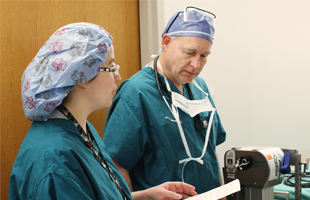Standardizing Care for Kids After Spine Surgery

When children who are non-ambulatory have spine surgery, their hospital stays afterward can range anywhere from four to nine days or more. It’s a wide variation—and one that the Cincinnati Children’s Division of Orthopaedics wanted to improve upon.
“We don’t want kids in the hospital any longer than they need to be. That’s the driver,” says pediatric orthopaedic surgeon Peter Sturm, MD, MBA.
Non-ambulatory spine surgery patients often have several comorbidities. This patient population can include kids with spina bifida and Duchenne muscular dystrophy who are wheelchair-dependent or those with cerebral palsy who may have significant developmental delays. “The patient might have other issues going on not necessarily related to orthopaedics that can keep them in the hospital longer,” Sturm explains. “You could have a child who, from an orthopaedic perspective, was ready to go home on day three, but because of gastro or pulmonary issues wasn’t going home until day 10.”
Collaboration Crucial to Success
Previously, a multidisciplinary team created new standardized protocols for care of kids with adolescent idiopathic scoliosis who had spine surgery. They succeeded in decreasing length of stay for that population from 4 days to 2.7 days. So they set out to attempt similar gains for the non-ambulatory population.
The initiative included participation from Orthopaedics, Pulmonary Medicine, Gastroenterology, the Pediatric Intensive Care Unit, Hospital Medicine, Physical Therapy, Anesthesia and Nutrition. Together they developed a post-op protocol with set goals for discharge. “A big part of what made this project so successful was having the high level of cooperation among everyone involved,” Sturm says.
The team was successful and decreased the length of stay for non-ambulatory patients after spine surgery from 8.4 days to 6.5 days. Because of this work, Sturm says, “We are able to provide better care because it’s standardized, and at the same time reduce costs.”
The division is next looking at standardizing post-op protocols for patients who have undergone hip surgery.

